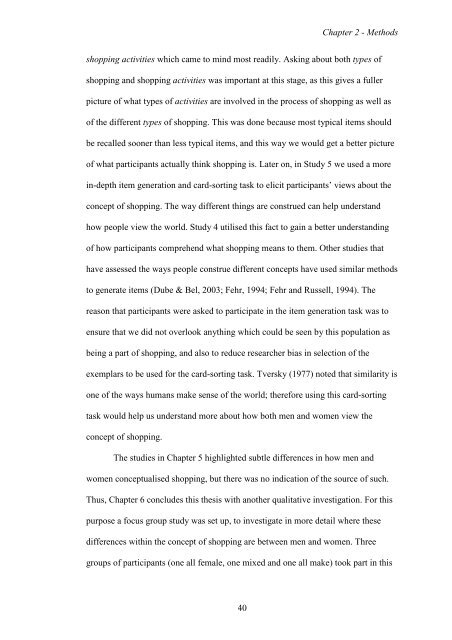CHAPTER 1 - University of Exeter
CHAPTER 1 - University of Exeter
CHAPTER 1 - University of Exeter
Create successful ePaper yourself
Turn your PDF publications into a flip-book with our unique Google optimized e-Paper software.
40<br />
Chapter 2 - Methods<br />
shopping activities which came to mind most readily. Asking about both types <strong>of</strong><br />
shopping and shopping activities was important at this stage, as this gives a fuller<br />
picture <strong>of</strong> what types <strong>of</strong> activities are involved in the process <strong>of</strong> shopping as well as<br />
<strong>of</strong> the different types <strong>of</strong> shopping. This was done because most typical items should<br />
be recalled sooner than less typical items, and this way we would get a better picture<br />
<strong>of</strong> what participants actually think shopping is. Later on, in Study 5 we used a more<br />
in-depth item generation and card-sorting task to elicit participants’ views about the<br />
concept <strong>of</strong> shopping. The way different things are construed can help understand<br />
how people view the world. Study 4 utilised this fact to gain a better understanding<br />
<strong>of</strong> how participants comprehend what shopping means to them. Other studies that<br />
have assessed the ways people construe different concepts have used similar methods<br />
to generate items (Dube & Bel, 2003; Fehr, 1994; Fehr and Russell, 1994). The<br />
reason that participants were asked to participate in the item generation task was to<br />
ensure that we did not overlook anything which could be seen by this population as<br />
being a part <strong>of</strong> shopping, and also to reduce researcher bias in selection <strong>of</strong> the<br />
exemplars to be used for the card-sorting task. Tversky (1977) noted that similarity is<br />
one <strong>of</strong> the ways humans make sense <strong>of</strong> the world; therefore using this card-sorting<br />
task would help us understand more about how both men and women view the<br />
concept <strong>of</strong> shopping.<br />
The studies in Chapter 5 highlighted subtle differences in how men and<br />
women conceptualised shopping, but there was no indication <strong>of</strong> the source <strong>of</strong> such.<br />
Thus, Chapter 6 concludes this thesis with another qualitative investigation. For this<br />
purpose a focus group study was set up, to investigate in more detail where these<br />
differences within the concept <strong>of</strong> shopping are between men and women. Three<br />
groups <strong>of</strong> participants (one all female, one mixed and one all make) took part in this
















